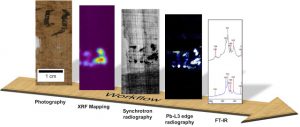The first thing that catches an archaeologist’s eye on the small piece of papyrus from Elephantine Island on the Nile is the apparently blank patch. Researchers from the Egyptian Museum, Berlin universities and Helmholtz-Zentrum Berlin have now used the synchrotron radiation from BESSY II to unveil its secret. This pushes the door wide open for analyzing the giant Berlin papyrus collection and many more.
For more than a century, numerous metal crates and cardboard boxes have sat in storage at the Egyptian Museum and Papyrus Collection Berlin, all of which were excavated by Otto Rubensohn from 1906 to 1908 from an island called Elephantine on the River Nile in the south of Egypt, near the city of Aswan.
Eighty percent of the texts on the papyrus in these containers have yet to be studied, and this can hardly be done using conventional methods anymore. Thousands of years ago, the Egyptians would carefully roll up or fold together letters, contracts and amulets to a tiny size so that they would take up the least possible space. In order to read them, the papyri would have to be just as carefully unfolded again.
Read more HERE
Ask me anything
Explore related questions





